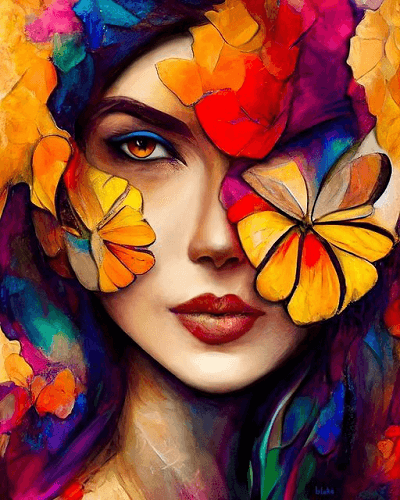The Intersection of National Politics and Aesthetic Appeals in Trump Art
The Intersection of National Politics and Aesthetic Appeals in Trump Art
Blog Article
Embarking on an Aesthetic Journey Via the Lyrical Interpretations of Nature in Impressionist Landscapes
Each brushstroke, each play of light and shadow, and each shade selection in their jobs speaks volumes about the artists' deep link to nature and their capacity to equate its beauty onto the canvas. As we check out the lyrical interpretations of nature in Stylist landscapes, we are welcomed to immerse ourselves in a globe where truth and emotion link, supplying a look right into the artists' extensive appreciation for the natural globe.
The Fascinating Brushstrokes of Claude Monet
Claude Monet's proficiency of brushstrokes transcends mere strategy, imbuing his landscapes with a spiritual top quality that fascinates and mesmerizes viewers - trump art. His cutting-edge use of shade and light, combined with his distinct brushwork, creates a feeling of movement and life within his paints. Monet's popular collection of works illustrating water lilies and his renowned haystacks display his ability to catch the short lived effects of light and ambience

Checking Out Light and Shadow With Camille Pissarro
Symbolizing a similar reverence for the interaction of light and darkness, Camille Pissarro's creative vision unravels as an unified exploration of the natural globe's luminous nuances. Pissarro, a crucial number in the Impressionist movement, masterfully caught the vibrant relationship between light and darkness in his landscapes. His experienced use shade and brushwork permitted him to convey the subtle changes in light that specify various times of day and seasons.
Pissarro's paintings usually feature dappled sunshine filtering system through leaves, casting complex patterns of light and darkness on the earth below. In works such as "Hoar Frost, the Result of Snow, Pontoise," Pissarro skillfully depicts the crisp illumination of wintertime sunshine juxtaposed with the cool darkness that define the snowy landscape. By accepting both light and shadow in his structures, Pissarro invites customers to immerse themselves in the all-natural appeal and transient results of light worldwide around them.

Via Pissarro's jobs, we are advised of the transformative power of light and darkness, welcoming us to stop and value the short lived minutes of elegance existing in the day-to-day landscapes that border us.
A Harmony of Color Styles by Edgar Degas
Edgar Degas coordinates a vivid harmony of shades in his skillful art work, infusing his structures with a dynamic interplay of hues that captivate the viewer's gaze. Recognized largely for his ballet professional dancers and intimate scenes of Parisian life, Degas adeptly controlled colors to communicate mood and movement in his paints. trump art. His usage of vibrant, different colors and subtle tonal variants developed a feeling of deepness and vibrancy within his works
Degas' color scheme frequently included abundant blues, deep eco-friendlies, and warm oranges, which he applied with confident brushstrokes to capture the essence of his topics. Whether representing a ballerina mid-performance or a team of close friends chatting at a coffee shop, Degas' colors not only showed the scene yet likewise evoked a sense of feeling and power.
Moreover, Degas' testing with light and darkness added an additional layer of intricacy to his shade make-ups, boosting the total ambience of his paints (trump art). With his experienced control of shade, Degas developed a visual symphony that remains to reverberate with customers today
Checking out Nature's Calmness With Berthe Morisot
Berthe Morisot's imaginative vision supplies a tranquil separation from the dynamic color harmonies of Edgar Degas, as she catches the tranquility of nature in her expressive landscapes. Understood for her delicate brushwork and intimate representations of daily life, Morisot's landscapes radiate a feeling webpage of peace and consistency.
Morisot's paints usually include soft, muted tones that share a sense of peace and calmness. Her works, such as "The Cradle" and "Summer season's Day," showcase her capacity to capture the refined appeal of nature in a way that is Web Site both contemplative and comforting to the visitor.
Unlike some of her Stylist equivalents who concentrated on strong shades and dynamic structures, Morisot liked to develop gentle, introspective scenes that welcome the viewer to stop briefly and reflect. Via her masterful usage of light and darkness, Morisot produces a feeling of harmony that reverberates with the audience on a deep psychological degree.
The Emotional Landscapes of Vincent Van Gogh
Vincent Van Gogh's landscapes clearly convey a deepness of emotion with their vibrant brushwork and meaningful use shade. The Dutch post-impressionist musician is renowned for his capability to catch extreme and raw emotions in his paintings, transcending typical representations of nature. Van Gogh's troubled personal life, marked by mental health and wellness struggles, greatly influenced his art, instilling his landscapes with a feeling their explanation of worry, moody, or spirit.
In jobs such as "Starry Night" and "Wheatfield with Crows," Van Gogh's swirling brushstrokes and vivid shade selections stimulate an extensive emotional reaction from customers. The unstable skies and upset landscapes in his paintings reflect his internal chaos and psychological turbulence, inviting audiences to look into the complexities of his psyche.
Van Gogh's distinct visual language, characterized by exaggerated viewpoints and vibrant use color, creates landscapes that resonate with viewers on a deeply psychological degree. With his art, Van Gogh invites us to see nature not simply as an outside truth but as a mirror of our innermost feelings and feelings.
Final Thought
In final thought, the impressionist landscapes of artists such as Claude Monet, Camille Pissarro, Edgar Degas, Berthe Morisot, and Vincent Van Gogh provide a unique and exciting aesthetic analysis of nature. Through their usage of brushstrokes, emotion, shade, and light, these musicians have developed a harmony of images that stimulate a sense of calmness and beauty in the all-natural world. Their jobs continue to inspire and charm customers with their lyrical interpretations of the landscapes around us.
Each brushstroke, each play of light and darkness, and each color selection in their works talks volumes concerning the artists' deep connection to nature and their capacity to translate its appeal onto the canvas. His cutting-edge use of shade and light, integrated with his unique brushwork, creates a sense of activity and life within his paints. His proficient usage of color and brushwork permitted him to communicate the subtle changes in light that define various times of day and seasons.

Report this page